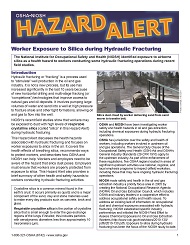OSHA/NIOSH Hazard Alert: Worker Exposure to Silica During Hydraulic Fracturing
June 2012
DHHS (NIOSH) Publication Number 2012-166

The National Institute for Occupational Safety and Health (NIOSH) identified exposure to airborne silica as a health hazard to workers conducting some hydraulic fracturing operations during recent field studies. Hydraulic fracturing or “fracking” is a process used to “stimulate” well production in the oil and gas industry. It is not a new process, but its use has increased significantly in the last 10 years because of new horizontal drilling and multi-stage fracking (or “completions”) technologies that improve access to natural gas and oil deposits. It involves pumping large volumes of water and sand into a well at high pressure to fracture shale and other tight formations, allowing oil and gas to flow into the well. NIOSH’s recent field studies show that workers may be exposed to dust with high levels of respirable crystalline silica (called “silica” in this Hazard Alert) during hydraulic fracturing. This Hazard Alert discusses the health hazards associated with hydraulic fracturing and focuses on worker exposures to silica in the air. It covers the health effects of breathing silica, recommends ways to protect workers, and describes how OSHA and NIOSH can help. Workers and employers need to be aware of the hazard that silica dust poses. Employers must ensure that workers are properly protected from exposure to silica. This Hazard Alert also provides a brief summary of other health and safety hazards to workers conducting hydraulic fracturing activities.
OSHA/NIOSH Hazard Alert: Worker Exposure to Silica During Hydraulic Fracturing
